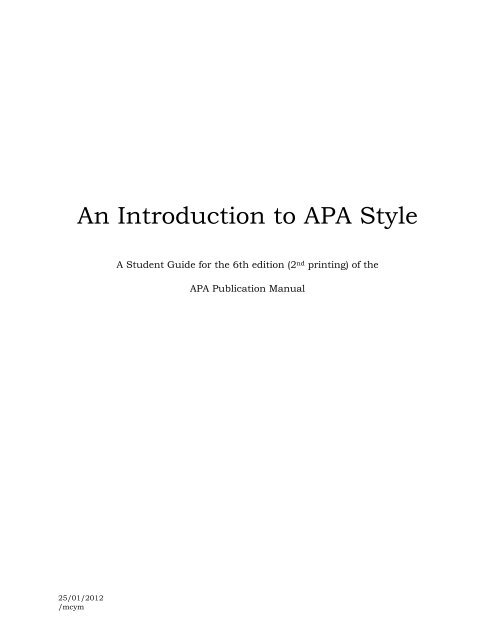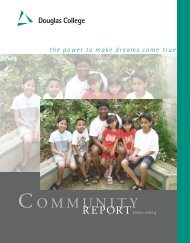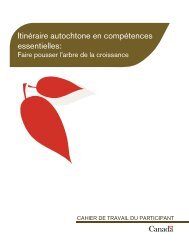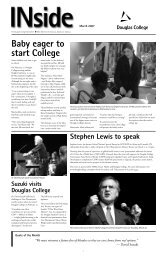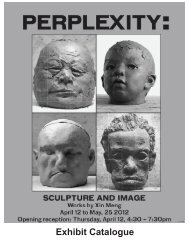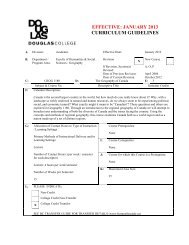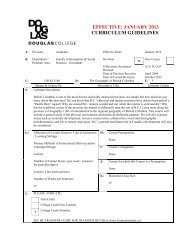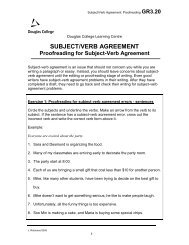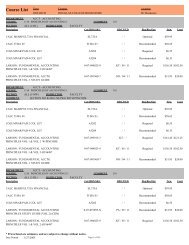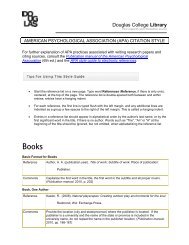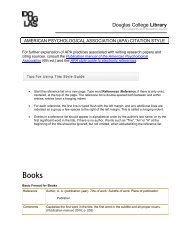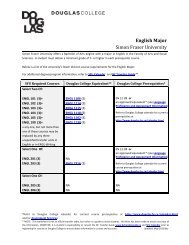An Introduction to APA Style - Douglas College
An Introduction to APA Style - Douglas College
An Introduction to APA Style - Douglas College
You also want an ePaper? Increase the reach of your titles
YUMPU automatically turns print PDFs into web optimized ePapers that Google loves.
<strong>An</strong> <strong>Introduction</strong> <strong>to</strong> <strong>APA</strong> <strong>Style</strong><br />
25/01/2012<br />
/mcym<br />
A Student Guide for the 6th edition (2 nd printing) of the<br />
<strong>APA</strong> Publication Manual
<strong>Introduction</strong> <strong>to</strong> <strong>APA</strong> <strong>Style</strong> 1<br />
25/01/2012<br />
/mcym<br />
AN INTRODUCTION TO WRITING IN <strong>APA</strong> STYLE<br />
This document provides an introduction <strong>to</strong> writing in American Psychological Association (<strong>APA</strong>)<br />
style. All of the information in this document is contained within the sixth edition (2 nd<br />
printing) of the Publication Manual of the American Psychological Association. If you need<br />
more details please refer <strong>to</strong> the <strong>APA</strong> manual available in the: <strong>Douglas</strong> <strong>College</strong> Library,<br />
Psychology Lab, and Learning Centre.<br />
The types of papers you will be asked <strong>to</strong> submit for grading will generally fall in<strong>to</strong> 2 categories:<br />
a literature review or an empirical study.<br />
Literature Review<br />
A literature review is a critical analysis of published work. The purpose of the literature review<br />
is <strong>to</strong>: define and clarify the problem; summarise previous research by identifying trends,<br />
similarities, differences, contradictions, gaps, and inconsistencies; and suggesting directions for<br />
future research. A literature review consists of, at minimum:<br />
title page<br />
abstract<br />
references<br />
Organising the body of the paper in<strong>to</strong> sections is at the discretion of the author: use the table<br />
below <strong>to</strong> format headings for each section according <strong>to</strong> <strong>APA</strong> style. At minimum, Level 1<br />
headings are required, but if two levels are needed, then use Levels 1 and 2 headings; if three<br />
levels are needed, then use Levels 1, 2, and 3 headings, etc.<br />
Level of heading Format<br />
1 Centred, Boldfaced, Uppercase and Lowercase Heading<br />
2 Flush left, Boldface, Uppercase and Lowercase Heading<br />
3 Indented, boldface, lowercase paragraph heading ending with a<br />
period.<br />
4 Indented, boldface, italicised, lowercase paragraph heading<br />
ending with a period.<br />
5 Indented, italicised, lowercase paragraph heading with a period.<br />
Empirical Study<br />
<strong>An</strong> empirical study is a report of original research in which an hypothesis is tested; data is<br />
collected; and the results are presented and evaluated. <strong>An</strong> empirical study consists of, at<br />
minimum:<br />
title page<br />
abstract<br />
introduction<br />
method<br />
results<br />
discussion<br />
references<br />
Formatting for a literature review and empirical study follows the same conventions. Because<br />
the sections within an empirical study are more prescriptive, this document focuses upon<br />
writing an empirical study.
<strong>Introduction</strong> <strong>to</strong> <strong>APA</strong> <strong>Style</strong> 2<br />
This document is divided in<strong>to</strong> three sections:<br />
1. Writing an <strong>APA</strong> style Empirical Study<br />
The first section provides a description of each of the major sections of an <strong>APA</strong> style empirical<br />
study.<br />
2. Citations and References<br />
The second section provides information on how <strong>to</strong> document your work; that is, it tells you<br />
how <strong>to</strong> cite and reference the articles that you will use when writing your paper. Read this<br />
section before gathering library materials (e.g., journal articles and books) and taking notes so<br />
you will know what type of information <strong>to</strong> record (e.g., author[s] name, date of publication,<br />
name of journal, doi). Also, carefully read the subsection on plagiarism.<br />
3. Sample <strong>APA</strong> style Empirical Study<br />
The third section provides an example of an <strong>APA</strong> style empirical study.<br />
25/01/2012<br />
/mcym
25/01/2012<br />
/mcym<br />
<strong>Introduction</strong> <strong>to</strong> <strong>APA</strong> <strong>Style</strong> 3<br />
General Guidelines<br />
Formatting<br />
Leave 2.54 cm (one inch) margins at the <strong>to</strong>p, bot<strong>to</strong>m, left and right sides of all the pages of the<br />
paper.<br />
Double space all lines of text including the title page and the reference section.<br />
Use boldface for the section headings (e.g., Methods, Results, Discussion) and sub-headings<br />
(e.g., Participants, Procedure)<br />
Use left justification only; leave the right edge of the text ragged.<br />
Use Times New Roman 12 pt.<br />
The running head is a shortened version of the title that is no more than 50 characters in length:<br />
this includes spaces, and punctuation. The running head and page number are 1.27cm or ½<br />
inch below the <strong>to</strong>p edge of the page.<br />
Typing: The text of the running head is typed in upper case. The running head and page<br />
number are on the same line with the running head left justified and the page number<br />
right justified. The running head and page number occurs on all pages of the<br />
document including the title page. NOTE: For the title page only, the words "Running<br />
head:" precedes the text of the running head (see p.1 of the Sample Paper).<br />
Indent paragraphs 5-7 spaces (1.27cm or ½”) ; do not indent the abstract.<br />
When reporting a numerical value, present the numerical value as digits if the value is greater<br />
than or equal <strong>to</strong> 10. If the numerical value is less than 10, type the value as a word, unless it<br />
contains a decimal.<br />
Submit a single-sided copy of your paper for grading.<br />
Staple the paper once in the upper left-hand corner. Do not use folders or duo-tangs.<br />
Make a backup copy of your paper.<br />
Comments on Writing <strong>Style</strong><br />
You should strive <strong>to</strong> present your ideas clearly and logically. Be precise in your choice of words.<br />
Get <strong>to</strong> the point, this is a scientific paper and therefore wordiness is frowned upon.<br />
Do not use colloquialisms (informal language): this is a formal paper.<br />
Refrain from making over-generalisations. For example, "Since the dawn of time, man has been<br />
intrigued about . . . "<br />
Academic papers are generally written in the third person. Although the use of personal<br />
pronouns are acceptable (e.g., we, our, I, my), they should be used judiciously: this is, after all, a<br />
formal paper. For example, both “The hypothesis for the experiment was . . .” (third person) and<br />
“Our hypothesis for the experiment was . . .” (first person), would be acceptable whereas “In my<br />
opinion, . . .” would be unacceptable because of the shift in <strong>to</strong>ne from formal <strong>to</strong> informal.<br />
The active voice is preferable <strong>to</strong> the passive voice. For example, it is preferable <strong>to</strong> say<br />
“Participants completed a questionnaire" (active voice) rather than “Participants were given a<br />
questionnaire" (passive voice).
<strong>Introduction</strong> <strong>to</strong> <strong>APA</strong> <strong>Style</strong> 4<br />
Title Page<br />
(See p. 1 of the Sample Paper)<br />
The title page is comprised of the following elements:<br />
title<br />
author's name(s)<br />
affiliation<br />
Title<br />
The title summarises the main <strong>to</strong>pic of the paper and mentions the variables considered in the<br />
study (e.g., The Effectiveness of Excuse-Validation in Reducing Negative Affect). The title is no<br />
more than 12 words. Remove unnecessary phrases such as "A Study of . . . ".<br />
Typing: The title is centred and typed in upper and lower case. The title appears in the<br />
<strong>to</strong>p half of the page.<br />
Author's Name<br />
Each author's name should be included on the title page.<br />
Typing: The author's first and last name is centred and double spaced below the title. If<br />
there is more than one author, then list the names in alphabetical order. Each<br />
author's name should be centred, doubled spaced and on a separate line below<br />
the previous author's name.<br />
Affiliation<br />
The affiliation is the name of the institution at which the study or experiment was conducted.<br />
Typing: The affiliation is typed in upper and lower case. It is centred and double spaced<br />
below the author(s) name.<br />
IMPORTANT NOTE: Your instruc<strong>to</strong>r may also ask you <strong>to</strong> include your student number, course<br />
name, section number, instruc<strong>to</strong>r's name and due date; check with your instruc<strong>to</strong>r. If you are<br />
required <strong>to</strong> include your student number, course and section number, and due date, then each<br />
of the entries would be centred and immediately below the preceding entry. For example, your<br />
student number would be centred and immediately below your name; the course and section<br />
number would be centred and immediately below your student number; and the due date<br />
would be centred and immediately below the course and section number.<br />
25/01/2012<br />
/mcym
<strong>Introduction</strong> <strong>to</strong> <strong>APA</strong> <strong>Style</strong> 5<br />
25/01/2012<br />
/mcym<br />
Abstract<br />
(See p. 2 of the Sample Paper)<br />
The abstract is a summary of the entire paper; do not include material that is not presented in<br />
the paper. The abstract is comprised of the following:<br />
the purpose of the research<br />
the variables being investigated<br />
a description of the participants<br />
a description of the method including materials, data gathering procedures, names of<br />
tests, etc.<br />
a description of your findings; do NOT include numerical results<br />
a conclusion<br />
The abstract is written in past tense. Report numerical values (e.g., number of participants) as<br />
digits unless the numerical value begins a sentence, in which case, report the numerical value<br />
as a word. The abstract is no more than 120 words.<br />
Typing: The abstract appears on the second page of the paper. The word "abstract" is<br />
centred, and written in upper and lower case. Do NOT indent the first line of the<br />
abstract.<br />
<strong>Introduction</strong><br />
(See pp. 3-5 of the Sample Paper)<br />
This section introduces the <strong>to</strong>pic being studied, reviews previous research, and clearly states<br />
the hypothesis for the study.<br />
Academic journal articles are used <strong>to</strong> review previous research; this is referred <strong>to</strong> as a literature<br />
review. The literature review is NOT a passive summary of each academic journal article, but<br />
an active, critical discussion of past research. The active discussion involves integrating and<br />
synthesising the main research trends as well as noting limitations of past research. Because<br />
you are borrowing ideas from previous research, this section will be filled with citations (see<br />
pp. 9-11 for examples of <strong>APA</strong> style citations). In addition, <strong>APA</strong> style rarely uses direct quotes;<br />
paraphrasing (putting it in<strong>to</strong> your own words), with proper citations, is preferred. The<br />
literature review should serve as a rationale for the present study and the hypothesis becomes<br />
a logical extension of the literature review. Past tense is used for the literature review.<br />
Following the literature review, the variables used in the present study are defined and the<br />
rationale for the hypothesis is developed. The hypothesis is then stated and predictions are<br />
made. At the end of the introduction, the reader should have a clear idea of what was expected<br />
<strong>to</strong> happen in the study and the reasons for the predictions. It is important <strong>to</strong> emphasise that<br />
the introduction section moves from the general (i.e., the general <strong>to</strong>pic, why it is important,<br />
theory, previous research findings) <strong>to</strong> the specific (i.e., the present study).<br />
Typing: The introduction section begins on the third page of the paper. The title of the<br />
paper is centred and printed in upper and lower case instead of the word<br />
"introduction". The introduction is approximately two <strong>to</strong> three pages in length.<br />
Each new paragraph should be indented 5-7 spaces (1.27cm or ½”) .
<strong>Introduction</strong> <strong>to</strong> <strong>APA</strong> <strong>Style</strong> 6<br />
25/01/2012<br />
/mcym<br />
Method<br />
(See pp. 5-6 of the Sample Paper)<br />
The method section describes how the study was conducted and is usually divided in<strong>to</strong>, at<br />
minimum, two subsections: (1) participants, and (2) procedure.<br />
Typing: The word "method" is boldfaced, centred, typed in upper and lower case, and<br />
immediately follows the last sentence of the introduction section.<br />
Participants<br />
The participants subsection describes the people who volunteered for the study. This includes<br />
information about the number of participants, their sex and average age and any other defining<br />
characteristics of the group of people (do not list details of individual participants).<br />
Typing: The word "participant" is boldfaced, left justified, and typed in upper and lower<br />
case. This subsection is written in past tense. The first line of this subsection is<br />
indented 5-7 spaces (1.27cm or ½”). When reporting the number of participants,<br />
present the number as digits if the numerical value is greater than or equal <strong>to</strong><br />
10. If the number of participants is less than 10, type the numerical value as a<br />
word.<br />
Procedure<br />
The procedure subsection provides a description of: the sampling procedure – how the<br />
participants were recruited – and sample size; the equipment and/or tests that were used; the<br />
research design; and a summary of the steps followed during data collection.<br />
When describing standard materials (e.g., s<strong>to</strong>p-watches) a detailed description is not required.<br />
If a test was used, cite the test name and author(s) in <strong>APA</strong> style and include the source of the<br />
test in the reference list. If the test (or data recording form) has instructions typed on the test<br />
form, describe the instructions; do not provide verbatim instructions. If the test uses a rating<br />
scale, include a description of the rating scale and how <strong>to</strong>tal scores are produced. When<br />
describing a test that uses a rating scale, type the rating scale as digits and the anchors for the<br />
scale should be italicised and in parentheses. For example, the participants rated their<br />
responses from 1 (most important) <strong>to</strong> 5 (least important).<br />
The description of the procedure should be in chronological order. Provide enough detail <strong>to</strong><br />
enable the reader <strong>to</strong> understand how the data was collected. This description should include:<br />
how participants were separated in<strong>to</strong> groups or conditions; where the testing <strong>to</strong>ok place; any<br />
verbal instructions given <strong>to</strong> each group or condition; the order of presentation of testing<br />
material; any experimental manipulations; how the dependent variable(s) were measured and<br />
any variables that were held constant.<br />
Typing: The word "procedure" is boldfaced, left justified, typed in upper<br />
and lower case and immediately follows the last sentence of the “participants”<br />
subsection. This subsection is written in past tense. The first line of this<br />
subsection and subsequent paragraphs are indented 5-7 spaces (1.27cm or ½”).
<strong>Introduction</strong> <strong>to</strong> <strong>APA</strong> <strong>Style</strong> 7<br />
25/01/2012<br />
/mcym<br />
Results<br />
(See pp. 7-8 of the Sample Paper)<br />
The main purpose of this section is <strong>to</strong> convey the numerical data obtained. Begin with a<br />
reiteration of the hypothesis. Describe the statistic that will be used <strong>to</strong> evaluate the results.<br />
Follow this with a written description of the results for each group or condition. Once all<br />
results have been reported, clearly state whether the results support the hypothesis; do not<br />
draw any conclusions.<br />
Report the mean (M), standard deviation (SD) for each group or condition and, when<br />
appropriate, the correlation coefficient (r); do NOT include the participants' individual scores.<br />
Raw data, if requested by your instruc<strong>to</strong>r, is included in the Appendix section (see the appendix<br />
sub-section of this document for appropriate <strong>APA</strong> style). Numerical results (M, SD, r,) are<br />
reported as digits. Report all results in sentence format. If a figure or table (see below for a<br />
description of an <strong>APA</strong> style figure or table) is included in this section, refer <strong>to</strong> the figure or table<br />
and state its relevance in the text of this section. The values you choose <strong>to</strong> report in this<br />
section should justify any conclusions you draw in the discussion section.<br />
NOTE: this section is written as a coherent paragraph(s).<br />
Typing: The word "results" is boldfaced, centred, typed in upper and lower case and<br />
appears immediately after the last sentence of the procedure subsection. This<br />
section is written in past tense and should be approximately one-half <strong>to</strong> one<br />
page long including a table or figure. The first line of this section and<br />
subsequent paragraphs are indented 5-7 spaces (1.27cm or ½”).<br />
Tables (see p. 8 of the Sample Paper)<br />
Your instruc<strong>to</strong>r may require a table as part of the results section. Tables are usually included<br />
if the results contain several sets of numbers that would be difficult <strong>to</strong> understand in sentence<br />
format. For example, if the results consisted of several means (M) and standard deviations<br />
(SD), reporting these values as a list of digits would detract from the readability and<br />
comprehension of the overall results. A table, therefore, serves as an organised presentation of<br />
the results. Values that are <strong>to</strong> be compared should be next <strong>to</strong> each other. For example, means<br />
(M) should be in one column, standard deviation (SD) should be in an adjacent column. Provide<br />
a brief summary of the table in the text of the results section; highlighting the relevant<br />
comparisons.<br />
Typing: Number each table with an Arabic numeral. The word "Table" and its<br />
corresponding number is left justified. The title for the table is italicised, left<br />
justified and underneath the table number. The heading for each column<br />
should be clear and concise; in addition, the heading should not be wider than<br />
the longest column entry. A horizontal line divides: the title from the headings;<br />
the headings from the numerical values; and the last row of the table from the<br />
rest of the text. Do NOT use vertical lines <strong>to</strong> separate each column.<br />
Figures (see p. 7 of the Sample Paper)<br />
Figures are graphs, charts, maps, drawings, pho<strong>to</strong>graphs, or diagrams. Your instruc<strong>to</strong>r may<br />
require a graph (referred <strong>to</strong> as a figure) of your results. The graph should provide a visual<br />
representation of the over-all results. Provide a brief description of the graph in the text of the<br />
results section. Unless otherwise specified, the graph should be computer generated.<br />
Typing: Label each axis indicating the quantity being measured and the units used.<br />
Each label is parallel <strong>to</strong> its axis; for example, the label for the ordinate/vertical<br />
axis should be printed vertically whereas the label for the abscissa/horizontal<br />
axis is printed horizontally. Provide the unit of measure in brackets after the<br />
label. Always include a zero point. Use a sans serif font, for example, Arial,<br />
Futura, or Helvetica for the labels and numbers of the ordinate and abscissa.<br />
The font size should be no larger than 14 pt and no smaller than 8 pt; the point<br />
size should not vary more than 4 pts. For example, if 8 pt is used for the<br />
ordinate then the font size cannot be greater than 12 pt for the abscissa. Type<br />
the axis labels in boldface. When choosing a grid scale, take in<strong>to</strong> consideration
<strong>Introduction</strong> <strong>to</strong> <strong>APA</strong> <strong>Style</strong> 8<br />
25/01/2012<br />
/mcym<br />
the range of both axes. The graph should be two dimensional NOT three<br />
dimensional . Unless printing from a colour printer, limit the colours for the<br />
bars <strong>to</strong> black and white: visually discriminating between different levels of<br />
shading can be difficult. If your graph includes a legend, then the legend should<br />
be centred with a box around it. Number all figures with Arabic numerals. The<br />
figure caption/title is below the figure. The word "Figure" and its corresponding<br />
number is left justified, italicised and followed by a period; one space after the<br />
period, type the title for the figure. The first letter of the title is in upper case<br />
with subsequent letters in lower case.<br />
Discussion<br />
(See pp. 8-10 of the Sample Paper)<br />
In the discussion section, the results are examined, interpreted, and evaluated. Inferences may<br />
be drawn. The discussion moves from the specific (e.g., your results described in words) <strong>to</strong> the<br />
general (e.g., why the results are theoretically important and how they relate <strong>to</strong> other findings<br />
in psychology). The discussion section usually opens by clearly stating whether the hypothesis<br />
was supported by the results. The results of the study are then evaluated against previous<br />
research. Discuss the similarities and differences between your results and past research<br />
results; limit your comments <strong>to</strong> those journal articles used in your literature review (include<br />
citations). Do NOT introduce new journal articles in this section. Do NOT repeat points already<br />
made or refer back <strong>to</strong> the introduction section; each new comment should help bolster your<br />
conclusions. The broader implications of the results should be discussed. If the results do not<br />
support the hypothesis, provide a plausible explanation; this should NOT be a litany of excuses.<br />
Methodological problems should be discussed with the expectation of suggestions <strong>to</strong> improve<br />
the study. Suggestions for future research may be provided.<br />
Typing: The word "discussion" is boldfaced, centred, typed in upper and lower case and<br />
immediately follows the results section. This section is written in present tense.<br />
The discussion is approximately 2-3 pages in length. The first line of this section<br />
and subsequent paragraphs are indented 5-7 spaces (1.27cm or ½”).<br />
References<br />
(See p. 11 of the Sample Paper)<br />
The reference section is a list of cited works in an <strong>APA</strong> paper. It appears at the end of the<br />
paper. Entries are listed in alphabetical order by authors' last name, or title if there is no<br />
author. Do not list articles that were not cited in your report, but include all articles that were<br />
cited. For more information on how <strong>to</strong> complete a reference list, please refer <strong>to</strong> pp. 12-17 of<br />
this document.<br />
Appendix<br />
(See pp. 12-13 of the Sample Paper)<br />
This section is optional; check with your instruc<strong>to</strong>r.<br />
The appendix contains information that is essential for the reader, but would be distracting in<br />
the body of the paper. For example, a long and detailed description of a complex piece of<br />
equipment may be necessary for the replication of a study but detracts from the readability of<br />
the method section. This description would then be placed in an appendix and referred <strong>to</strong> in<br />
the body of the paper. As mentioned in the results section, your instruc<strong>to</strong>r may want you <strong>to</strong><br />
include the participants' scores. The participants' scores would be included in the appendix.<br />
To draw the reader's attention <strong>to</strong> the participants' scores refer <strong>to</strong> them in the results section of<br />
the paper. Signed consent forms, if required by your instruc<strong>to</strong>r, should also be included as<br />
part of the appendix.<br />
Typing: The word "appendix" is centred, typed in upper and lower case, with<br />
an identifying letter typed in upper case. Each appendix is typed on a separate<br />
page. If there is only one appendix, then an identifying letter is not necessary.<br />
The appendix follows the reference list.
<strong>Introduction</strong> <strong>to</strong> <strong>APA</strong> <strong>Style</strong> 9<br />
25/01/2012<br />
/mcym<br />
CITATIONS AND REFERENCES<br />
Psychology papers must be referenced using <strong>APA</strong> referencing style. This style requires<br />
reference citations in the text of the paper and a reference list at the end. Reference citations<br />
identify the source of an idea, a paraphrase, or a direct quote. They include the name of the<br />
author(s) and year of publication of the original information. Reference citations are used <strong>to</strong><br />
indicate <strong>to</strong> the reader which ideas are your own and which came from other sources. If you<br />
present ideas that are not your own, it is critical <strong>to</strong> acknowledge the source(s) of the ideas by<br />
making an appropriate reference citation. Moreover, it is critical that you paraphrase the<br />
words of other authors, that is, “say it in your own words.” If you fail <strong>to</strong> acknowledge your<br />
sources, fail <strong>to</strong> paraphrase the work of other authors, or both, you will be committing an act of<br />
academic dishonesty called plagiarism. The consequences can be severe.<br />
Plagiarism<br />
Plagiarism is the formal presentation or submission of research, words, ideas, illustrations or<br />
diagrams of others as one's own without citation or credit.<br />
Confirmed violations of the <strong>College</strong>'s academic dishonesty policy will be dealt with forthrightly<br />
and decisively by Faculty and Administration. In the case of a first offence, the penalties may<br />
include, but are not limited <strong>to</strong>, one or more of the following:<br />
rewriting of the assignment;<br />
completion of another assignment;<br />
a zero percent grade assigned <strong>to</strong> the relevant evaluation component;<br />
a failing grade on the course as a whole;<br />
suspension from the program and/or <strong>College</strong>; and/or<br />
permanent expulsion from the <strong>College</strong><br />
Penalties will be noted on the student’s academic record for a time period specified by the<br />
Dean/Designate.<br />
The student will be informed by the President that the consequences of a second offence will be<br />
permanent expulsion from the <strong>College</strong>.<br />
For details see: http://www.douglas.bc.ca/about/policies/edu/academdis.html<br />
Paraphrasing<br />
<strong>APA</strong> style writing rarely includes direct quotes; paraphrasing is more common. Paraphrasing<br />
involves writing ideas, concepts, and theories from a source in your own words. Replacing a<br />
few words, rearranging the words, and/or splicing sentences <strong>to</strong>gether from a source is NOT<br />
paraphrasing – this would be considered plagiarism because you are using the source’s words,<br />
but claiming them as your own. Although the ideas, concepts and/or theories are now in your<br />
own words, you still need <strong>to</strong> acknowledge the source hence the use of citations: see pages 10-<br />
11 for examples of <strong>APA</strong> citations.<br />
Quotations<br />
It is better <strong>to</strong> paraphrase than <strong>to</strong> quote. <strong>An</strong>y material of three or more words taken from<br />
another source is a quote. When quoting, ensure that the words, punctuation, and grammar is<br />
an exact replica of the original source. In addition <strong>to</strong> the author(s) name and year of<br />
publication, the page number for the quotation MUST be included. When quoting from a<br />
source that does not provide page numbers use paragraph numbers (type “para.” and the<br />
number) or, if the paper is divided in<strong>to</strong> sections, provide the section and the paragraph number<br />
(type “para.” and the number) within that section.
<strong>Introduction</strong> <strong>to</strong> <strong>APA</strong> <strong>Style</strong> 10<br />
If the quotation is short ( 40 words) insert the quotation as part of the sentence. Remember <strong>to</strong><br />
enclose the quote with quotation marks.<br />
Example: Rea (1988) has stated that "the Mini University provided a unique and creative<br />
educational experience for both the instruc<strong>to</strong>rs and the students" (p. 303).<br />
If the quote is greater than 40 words type the quote as a separate block. The block quote is<br />
double spaced, indented 5-7 spaces, (1.27cm or ½"), and is NOT surrounded by quotation<br />
marks.<br />
25/01/2012<br />
/mcym<br />
REFERENCE CITATIONS IN TEXT<br />
The surname of the author and the date of publication are inserted directly in<strong>to</strong> the text at the<br />
point were the author's work is mentioned. The complete citation is included in the reference<br />
list at the end of the paper. Put parentheses around the author, the date, or both if they do not<br />
form a normal part of the sentence.<br />
Example: In 1993, Smith compared reaction times . . .<br />
or Smith (1993) compared reaction times . . .<br />
or In a study of reaction times (Smith, 1993) . . .<br />
To ensure your sentence is grammatically correct, the sentence should be complete without the<br />
information contained within the parentheses.<br />
1. One Author<br />
Insert the author's last name and the date of publication in<strong>to</strong> the text.<br />
Example: More than 80% of the parents that evaluated the program considered it a<br />
success (Rea, 1988).<br />
2. Two Authors<br />
When there are two authors always cite both last names.<br />
Example: In an earlier study (Neisser & Harsch, 1992) . . .<br />
The symbol "&" is used when in parentheses. Use the word "and" when the authors' names are<br />
part of the sentence.<br />
Example: <strong>An</strong> earlier study by Neisser and Harsch (1992) . . .<br />
3. More than Two Authors<br />
When there are three <strong>to</strong> five authors, cite all the last names in the first citation and in the<br />
following citations use only the first name and "et al." (which is Latin for "and others").<br />
NOTE: that "et" is not followed by a period, but "al" is.<br />
First citation: Sokolowski, Smith, Jones, and Hajid (1983) discovered . . .<br />
Subsequently: Sokolowski et al. (1983) also found that . . .<br />
or The results were supported by a later discovery (Sokolowski et al., 1983).
<strong>Introduction</strong> <strong>to</strong> <strong>APA</strong> <strong>Style</strong> 11<br />
When there are six or more authors, cite only the first author’s last name followed by “et al.” for<br />
the first and subsequent citations.<br />
Exception: If two or more references have the same first author and year of publication, then<br />
include as many subsequent author’s last names as necessary <strong>to</strong> clearly identify the source,<br />
followed by a comma, “et al.” and the year of publication.<br />
First citation: Bodenhausen, Kramer, and Süsser (1994) and Bodenhausen, Sheppard,<br />
and Kramer (1994) found . . .<br />
Subsequently: Bodenhausen, Kramer, et al. (1994) and Bodenhausen, Sheppard, et al.<br />
(1994) concluded . . .<br />
or The results were supported by a later discovery (Bodenhausen, Kramer,<br />
et al., 1994; Bodenhausen, Sheppard, et al., 1994).<br />
4. Groups as Authors<br />
The full name of a group that serve as an author such as corporations, associations, and<br />
government agencies is written out unless the abbreviation is well known.<br />
Example: A recent study by The <strong>Douglas</strong> <strong>College</strong> Department of Institutional Research<br />
(1994) . . .<br />
but A police report (Royal Canadian Mounted Police, 1979 [RCMP]) . . .<br />
then The RCMP report (1979) . . .<br />
5. Citing a Secondary Source<br />
Authors refer <strong>to</strong> other researchers' work in their writing. If you would like <strong>to</strong> include this<br />
information in your paper the best thing <strong>to</strong> do is look up these sources yourself. In lieu of that,<br />
you must cite this material as a secondary source. Give the name of the original author(s)<br />
within the text of your paper along with the author(s) and date of the paper you actually read.<br />
For example, if you read about Treisman and Davies' study in a paper by Hirst and Kalmar<br />
(1987), the citation in the text of your paper would be:<br />
In Treisman and Davies’ study (as cited in Hirst & Kalmar, 1987) . . .<br />
NOTE: For how <strong>to</strong> reference a secondary source, see “reference for a secondary source” on<br />
p. 13, number 4.<br />
25/01/2012<br />
/mcym
<strong>Introduction</strong> <strong>to</strong> <strong>APA</strong> <strong>Style</strong> 12<br />
25/01/2012<br />
/mcym<br />
REFERENCE LIST<br />
The purpose of a reference list is <strong>to</strong> enable the reader <strong>to</strong> retrieve the sources for the document.<br />
As a general rule, references are alphabetised according <strong>to</strong> the first author’s last name, with<br />
additional rules for the following circumstances:<br />
2 or more references with the same first author: alphabetise based on the subsequent<br />
authors’ last name.<br />
2 or more references from the same author(s), but a different publication year: list the<br />
sources in chronological order.<br />
2 or more references with identical author(s) and publication year: insert a lowercase<br />
letter – a, b, c, etc., – at the end of the publication year, but before the parentheses <strong>to</strong><br />
uniquely identify each source. NOTE: the lettered publication year will be used when citing<br />
the article in the paper.<br />
8 or more authors: list the first six authors’ names, followed by three ellipses (. . .), then<br />
insert the last author’s name (see “without accession number” on page 14, number 7b).<br />
Referencing for electronic and print form sources are identical with the addition of a retrieval<br />
location for an electronic source. Many scholarly full-text sources have begun <strong>to</strong> use a Digital<br />
Object Identifier (DOI) which provides a permanent link <strong>to</strong> a research article. The DOI begins<br />
with a “10” and is an alphanumeric value that can be found where the “Abstract” is visible<br />
when using a database such as “PsycINFO/PsycARTICLES” and/or on the first page of a<br />
research article. Copy and paste the DOI in<strong>to</strong> your reference list <strong>to</strong> minimise transcription<br />
errors. If the DOI is not visible, it may be hidden under but<strong>to</strong>ns labelled “Article”, “CrossRef”,<br />
“PubMed” or another full-text vendor source. Because a DOI is a permanent link <strong>to</strong> the journal<br />
article, a retrieval date, name of the database, and accession number is no longer necessary. If<br />
a DOI is unavailable, then use the URL. When using a URL, make sure the link is <strong>to</strong> the home<br />
page for the journal, magazine or newsletter. NOTE: If the retrieved source was in print form,<br />
but a DOI is available, then include the DOI as part of the reference.<br />
Typing: The word "reference" is centred, typed in upper and lower case, and appears on<br />
a separate page. Each new entry is flush left, with the subsequent line of the<br />
entry indented 5-7 spaces (1.27cm or ½”), referred <strong>to</strong> as a hanging indent. The<br />
titles of books, journals and volume numbers are italicised.<br />
Below and on the subsequent pages are examples of how <strong>to</strong> reference various sources.<br />
Periodicals<br />
1. Online Journal with a DOI<br />
Krebs, D. L., & Den<strong>to</strong>n, K. (2006). Explana<strong>to</strong>ry limitations of cognitive-<br />
developmental approaches <strong>to</strong> morality. Psychological Review, 113(3),<br />
672-675. doi: 10.1037/0033-295X.113.3.672<br />
Authors: Krebs, D. L., & Den<strong>to</strong>n, K. (only provide each author's surname and initials; do not<br />
include first names)<br />
Most recent date of publication: 2006<br />
Title of article: Explana<strong>to</strong>ry limitations of cognitive-developmental approaches <strong>to</strong> morality.<br />
Name of journal: Psychological Review (italicised)<br />
Volume number of journal: 113 (italicised)<br />
Issue number: 3 (in brackets, but not italicised)<br />
Page numbers: 672-675<br />
Note: the italicised text shown above is not included in the reference section. It is provided<br />
here <strong>to</strong> help you understand the components of a journal entry.
<strong>Introduction</strong> <strong>to</strong> <strong>APA</strong> <strong>Style</strong> 13<br />
2. Online Journal without a DOI<br />
Vicki, G. T., Thomae, M., Cullen, A., & Fernandez, H. (2007). The effect of<br />
25/01/2012<br />
/mcym<br />
sexist humor and type of rape on men’s self-reported rape proclivity and<br />
victim blame. Current Research in Social Psychology, 13(10), 122-132.<br />
Retrieved from http://www.uiowa.edu/~grpproc/crisp/crisp.html<br />
3. Journal in print form<br />
Eich, E., & Macaulay, D. (2000). Are real moods required <strong>to</strong> reveal mood-<br />
congruent and mood-dependent memory? Psychological Science, 11(3), 244-<br />
248.<br />
4. Reference for a secondary source<br />
The example used in “citing a secondary source” referred <strong>to</strong> Treisman and Davies' study that<br />
was cited in Hirst and Kalmar's (1987) paper. In the reference section, only the paper by Hirst<br />
and Kalmar (1987) would be listed. For example:<br />
Hirst, W., & Kalmar, D. (1987). Characterizing attentional resources. Journal<br />
Abstract<br />
of Experimental Psychology: General, 116(1), 68-81.<br />
Abstracts may be acceptable by some instruc<strong>to</strong>rs as sources for information although, as a<br />
general rule, it is preferable <strong>to</strong> use the full-text article. When referencing an abstract from a<br />
database, include the accession number if available.<br />
6. Online Abstract as original source<br />
Perilloux, C., & Buss, D. M. (2008). Breaking up romantic relationships:<br />
Costs experienced and coping strategies deployed. Evolutionary<br />
Psychology, 6(1), 164-181. Abstract retrieved from<br />
http://www.epjournal.net<br />
7. Online Abstract from a secondary source (e.g. database)<br />
a) with accession number<br />
Dent, K., Johns<strong>to</strong>n, R. A., & Humphreys, G. W. (2008). Age of acquisition and<br />
word frequency effects in picture naming: A dual task investigation.<br />
Journal of Experimental Psychology: Learning, Memory and Cognition,<br />
34(2), 282-301. Abstract retrieved from PsycINFO database.(Accession No.<br />
2008-02158-002)
<strong>Introduction</strong> <strong>to</strong> <strong>APA</strong> <strong>Style</strong> 14<br />
25/01/2012<br />
/mcym<br />
b) without accession number<br />
O’Connor, K., Marchand, A., Brousseau, L., Aardema, F., Mainguy, N., Landry,<br />
P., . . . Bouthillier, D. (2008). Cognitive-behavioural,<br />
pharmacological and psychosocial predic<strong>to</strong>rs of outcome during tapered<br />
discontinuation of benzodiazepine. Clinical Psychology & Psychotherapy,<br />
15(1), 1-14. Abstract retrieved from Wiley InterScience database.<br />
8. Abstract in print form<br />
Roese, N. J., Penning<strong>to</strong>n, G. L., Coleman, J., Janicki, M., Li, M. P., &<br />
Books<br />
Kenrick, D. T. (2006). Sex differences in regret: All for love or some<br />
for lust? [Abstract]. Personality and Social Psychology Bulletin,<br />
32(6), 770-780.<br />
9. Online Book<br />
As with online journals, if a DOI is available, use the DOI instead of a URL.<br />
Perfect, T. J., & Schwartz, B. L. (Eds.) (2002). Applied metacognition.<br />
Retrieved from http://www.questia.com/read/107598848<br />
Author: Perfect, T. J., & Schwartz, B. L. (only provide the author’s surname and initials; do not<br />
include first names)<br />
Most recent date of publication: 2002<br />
Title: Applied metacognition (italicised)<br />
Note: the italicised text shown above is not included in the reference section. It is provided<br />
here <strong>to</strong> help you understand the components of a book entry. The examples given below<br />
follow a similar convention.<br />
10. Book in print form<br />
Myers, D. G. (2007). Psychology (1st Canadian ed.). New York, NY: Worth.<br />
11. Chapter from an Online Book<br />
Lachkar, J. (2004). The couple: The dance, the drama, and the bond. In The<br />
narcissistic/borderline couple: New approaches <strong>to</strong> marital therapy (2nd<br />
ed., pp. 33-54). Retrieved from http://www.questia.com/read/107512508#
<strong>Introduction</strong> <strong>to</strong> <strong>APA</strong> <strong>Style</strong> 15<br />
12. Chapter from a book in print form<br />
Krebs, D. L., & Den<strong>to</strong>n, K. (1997). Social illusions and self deception: The<br />
25/01/2012<br />
/mcym<br />
evolution of biases in person perception. In J. A. Simpson & D. T.<br />
Kenrick (Eds.), Evolutionary social psychology (pp.21-48). Hillsdale,<br />
NJ: Erlbaum.<br />
13. Book with more than one author<br />
Elmes, D. G., Kan<strong>to</strong>witz, B. H., & Roediger, H. L. III (1992). Research<br />
methods in psychology (4th ed.). St. Paul, MN: West.<br />
14. Book with government agency or corporate author<br />
American Psychiatric Association. (2000). Diagnostic and statistical<br />
manual of mental disorders (4th ed., text revision). Washing<strong>to</strong>n, DC:<br />
Author.<br />
Dictionary or Encyclopaedia<br />
15. Online Dictionary<br />
Cognition. (2008). In Oxford reference online premium dictionary. Retrieved<br />
from http://www.oxfordreference.com<br />
16. Online Encyclopaedia<br />
Schizoaffective disorder. (2008). In R. S. Porter, J. L. Kaplan, B. P.<br />
Homeier, & M. H. Beers (Eds.), The Merck manuals on-line medical<br />
library. Retrieved from http://www.merck.com<br />
17. Dictionary or Encyclopaedia in print form<br />
Colman, A. (2003). Oxford dictionary of psychology. New York, NY: Oxford<br />
Magazine<br />
University Press.<br />
18. Online magazine article<br />
Blue, L. (2008, March 12). Is our happiness preordained? [Online exclusive].<br />
Time. Retrieved from http://www.time.com/time/health<br />
NOTE: If the on-line article can be located using “search” on the publication’s homepage, then<br />
provide the URL <strong>to</strong> the homepage only, otherwise include the entire URL.
<strong>Introduction</strong> <strong>to</strong> <strong>APA</strong> <strong>Style</strong> 16<br />
19. Magazine article in print form<br />
George. L. (2007, April 9). The secret <strong>to</strong> not losing your marbles. Macleans,<br />
Newspaper<br />
25/01/2012<br />
/mcym<br />
120(13), 36-39.<br />
20. Online newspaper article<br />
Kirkey, S. (2008, January 30). Toron<strong>to</strong> team discovers memory tune-up. The<br />
Vancouver Sun. Retrieved from http://www.canada.com/vancouversun/news/<br />
s<strong>to</strong>ry.html?id=490bc3ba-7e2e-463c-8f54-d9e989d164d8&p=2<br />
NOTE: If the on-line article is available using “search”, then provide the URL <strong>to</strong> the homepage<br />
otherwise include the entire URL.<br />
21. Newspaper article in print form<br />
Tanner, L. (2008, March 19). Gene variations linked <strong>to</strong> severity of PTSD. The<br />
Globe and Mail, p. L4.<br />
Audiovisual Media<br />
22. Video<br />
Davidson, F. W. (Producer), & Davidson, J. M. (Direc<strong>to</strong>r). (1996). Play: A<br />
Vygotskian approach [VHS]. USA: Davidson Films.<br />
The generic format:<br />
Producer, A. A. (Producer). & Direc<strong>to</strong>r, B. B. (Direc<strong>to</strong>r). (Year). Title of the motion picture<br />
[Motion Picture, or medium of recording e.g., DVD, VHS]. Country of Origin: Studio.<br />
23. Podcast<br />
Green, C. D. (Producer). (2009, Oc<strong>to</strong>ber 9-15). Thomas Blass on Stanley<br />
Milgram’s shocking studies of obedience [Audio podcast]. Retrieved from<br />
www.yorku.ca/chris<strong>to</strong>/podcasts/<br />
24. Episode from a television series<br />
Vattano, F. J., Bennett, T. L., & Butler, M. (Writers), & Maher, T.<br />
(Direc<strong>to</strong>r). (1997). Living with amnesia: The hippocampus and memory.<br />
In M. Ellis & R. Bend (Producers), The brain: Teaching modules (2nd<br />
ed.). New York, NY: WNET.<br />
Follow the format for a chapter in a book, except insert the writer(s) and direc<strong>to</strong>r(s) name in<br />
place of the author(s) of the chapter; and insert the name of the producer(s) in place of the<br />
edi<strong>to</strong>r.
<strong>Introduction</strong> <strong>to</strong> <strong>APA</strong> <strong>Style</strong> 17<br />
Curriculum and Course Material<br />
25. Presentation Slides<br />
Kurt, A. (2008). Lecture 7: Learning [PowerPoint slides]. Retrieved from<br />
25/01/2012<br />
/mcym<br />
http://mydouglas.douglas.bc.ca/cp/group<strong>to</strong>ols/fileshare/11049/16631/<br />
Lecture 7 Learning.pdf<br />
26. Lecture notes<br />
Jackson, J. (2008). Psychology 2300 – introduction <strong>to</strong> statistics: Lecture 6.<br />
Retrieved from http://webct6.douglas.bc.ca/webct/urw/lc5116001.tp0/<br />
cobaltMainFrame.dowebct?JSESSIONID=9s2xHhwT3sYvTp52pc1J1rLQDTHvH2<br />
qKgVs30fvk1Ds87vJ2wNFg!176160837!webct6.douglas.bc.ca!80!443
<strong>Introduction</strong> <strong>to</strong> <strong>APA</strong> <strong>Style</strong> 18<br />
25/01/2012<br />
/mcym<br />
References<br />
American Psychological Association. (2010). Publication manual of the American Psychological<br />
Association (6th ed.). Washing<strong>to</strong>n, DC: Author.
Running head: EXCUSE-VALIDATION AS SOCIAL SUPPORT 1<br />
The Effectiveness of Excuse-Validation in Reducing Negative Affect<br />
Kathy Den<strong>to</strong>n<br />
<strong>Douglas</strong> <strong>College</strong>
EXCUSE-VALIDATION AS SOCIAL SUPPORT 2<br />
Abstract<br />
Excuse-making is a common strategy people invoke <strong>to</strong> feel better following a negative event.<br />
When excuses are advanced in public, their effectiveness may depend on whether they are<br />
validated by others. The present study was conducted <strong>to</strong> assess the emotional impact on<br />
participants of having their excuses validated by a supportive stranger in a conversation about a<br />
real life negative event, as compared <strong>to</strong> receiving no support from an attentive audience.<br />
Participants were 31 male and 39 female undergraduate students, who participated for course<br />
credit. Participants' affective state was assessed prior <strong>to</strong> and after talking <strong>to</strong> a supportive stranger<br />
who either validated or did not validate their excuses. It was hypothesized that participants in the<br />
excuse-validation condition would report lower levels of negative affect at the post-conversation<br />
assessment than participants whose excuses were not validated. The results indicated that<br />
excuse-validation is an effective form of social support and is necessary for publicly made<br />
excuses <strong>to</strong> alleviate negative affect.
EXCUSE-VALIDATION AS SOCIAL SUPPORT 3<br />
The Effectiveness of Excuse-Validation in Reducing Negative Affect<br />
Social psychology is replete with evidence that people who receive information that<br />
threatens their sense of self, such as a negative evaluation, will dis<strong>to</strong>rt the information in self-<br />
serving ways (see Miller & Porter, 1988; Snyder & Higgins, 1988; Taylor & Brown, 1988, for<br />
reviews). Snyder, Higgins, and Stucky (1983) have demonstrated that making excuses (e.g.,<br />
trivializing negative feedback, making an external attribution for the cause of an unfavourable<br />
outcome) is a common way in which people attempt <strong>to</strong> construct a less threatening reality<br />
following upsetting experiences.<br />
Investigations of excuses and related processes tend <strong>to</strong> focus on excuses people make in<br />
private, labora<strong>to</strong>ry contexts after receiving some form of negative feedback (see Snyder &<br />
Higgins, 1988, for a review). The results of this research suggest that processes that help people<br />
evade responsibility for their negative outcomes, such as excuses, are beneficial. Excuses<br />
preserve people's self-concepts and alleviate negative affect associated with unfavourable<br />
outcomes (Snyder & Higgins, 1988; Taylor & Brown, 1988).<br />
It is unclear whether excuses provide relief from negative events when they are advanced<br />
outside of the lab, in public contexts. Few researchers have assessed the effectiveness of<br />
publicly-made excuses. Three studies (Den<strong>to</strong>n & Zarbatany, 1996; Mehlman & Snyder, 1985;<br />
Schönbach, 1990), however, suggest the effectiveness of publicly-made excuses may depend on<br />
the audience who receives the excuse and context in which the excuse is invoked.<br />
A study by Schönbach (1990) revealed that audiences in competitive or antagonistic<br />
contexts (e.g., people on an opposing side of a dispute) have a vested interest in challenging<br />
people's excuses, which constrains the excuse-maker's ability <strong>to</strong> evade responsibility and <strong>to</strong><br />
alleviate negative affect. Similarly, a study by Mehlman and Snyder (1985) demonstrated that
EXCUSE-VALIDATION AS SOCIAL SUPPORT 4<br />
excuses examined by an "all knowing," electronic audience in an experimental context were<br />
constrained by anticipated challenges <strong>to</strong> their validity, and, therefore, less effective than<br />
privately-made, unexamined excuses in relieving negative affect.<br />
In contrast, in a study of social support strategy effectiveness, Den<strong>to</strong>n and Zarbatany<br />
(1996) observed that when people discussed real life negative experiences with friends during<br />
supportive conversations, their friends not only agreed with their excuses (i.e., provided excuse-<br />
validation) but also made excuses for them. In terms of the effectiveness of excuses and excuse-<br />
validation in reducing negative affect, Den<strong>to</strong>n and Zarbatany (1996) reported that the excuses<br />
people made for themselves were ineffective in reducing negative affect; but, friends' validation<br />
of these excuses helped alleviate negative affect. Indeed, the validation of excuses by friends<br />
was found <strong>to</strong> be a more effective support strategy than any other form of social support or coping<br />
assessed in this study (i.e., excuse-making, emotional support, advice, discussing a more pleasant<br />
<strong>to</strong>pic). The correlational nature of this study, however, does not permit conclusions <strong>to</strong> be drawn<br />
about whether excuse-validation caused reductions in negative affect or was a consequence of<br />
negative affect reduction.<br />
The present study was a first attempt <strong>to</strong> test the effectiveness of excuse-validation as a<br />
social support strategy in a controlled experiment. Participants discussed a real-life negative<br />
event with a supportive stranger who either validated their excuses or listened attentively without<br />
providing excuse-validation. Prior <strong>to</strong> and after this discussion, participants completed a<br />
questionnaire <strong>to</strong> assess their level of negative affect. Based on past correlational research on<br />
excuse-validation (Den<strong>to</strong>n & Zarbatany, 1996) and related research on the effects of implicit<br />
(Mehlman & Snyder, 1985) and explicit (Schönbach, 1990) challenges <strong>to</strong> people's excuses, it was
EXCUSE-VALIDATION AS SOCIAL SUPPORT 5<br />
expected that participants whose excuses were validated would benefit more from the supportive<br />
conversation than participants whose excuses were not validated.<br />
Participants<br />
Method<br />
Participants were 31 male and 39 female undergraduate students (M age = 25.8) who<br />
attended the University of Western Ontario. Participants were <strong>to</strong>ld that the study assessed how<br />
people talk about negative events. Volunteers received course credit for their participation.<br />
Procedure<br />
Two brief versions of the Multiple Affect Adjective Check List (MAACL; Zuckerman &<br />
Lubin, 1965) were used <strong>to</strong> assess negative affect (see Appendix). Each checklist contained 42<br />
words that described various emotional states (e.g., happy, nervous). Participants were instructed<br />
<strong>to</strong> read each item and place an “x” beside those items that described how they felt at that<br />
moment. Total negative affect scores were created by adding <strong>to</strong>gether the number of negative<br />
emotional words in each of three subscales (i.e., anxiety, depression, anger) that were marked<br />
with an “x” and the number of positive emotional words (e.g., relaxed, happy) that were not<br />
marked with an “x,” then dividing by three. The highest possible score on the test was 14, which<br />
indicated a very high level of negative affect.<br />
In addition <strong>to</strong> the MAACL, a short, written questionnaire was created for this study. This<br />
five-item questionnaire assessed participants impressions of the supportive stranger (e.g., How<br />
supportive was she? How comfortable did you feel talking <strong>to</strong> her?). Responses were made on<br />
seven-point rating scales and aggregated <strong>to</strong> produce an impression of supportive stranger score.<br />
The higher the score, the more positively participants viewed the supportive stranger.
EXCUSE-VALIDATION AS SOCIAL SUPPORT 6<br />
A research assistant contacted potential participants by telephone and provided them with<br />
a brief description of the study. Meeting times were arranged for volunteers, who were tested<br />
individually in a Psychology lab.<br />
When participants arrived at the Psychology lab, the experimenter asked them <strong>to</strong> (a)<br />
disclose an upsetting incident from their past that still bothered them <strong>to</strong> think about and (b)<br />
complete a brief version of the MAACL. Next, participants discussed the incident they disclosed<br />
<strong>to</strong> the experimenter with a "supportive stranger" (who was referred <strong>to</strong> as a research assistant) for<br />
seven minutes in front of a video camera.<br />
During the seven-minute conversation, the supportive stranger interacted with<br />
participants according <strong>to</strong> the social support requirements of the experimental condition <strong>to</strong> which<br />
subjects’ were randomly assigned: excuse-validation or attentive listening. In the excuse-<br />
validation condition, the supportive stranger was instructed <strong>to</strong> validate every excuse participants<br />
made by nodding or by verbalizing agreement. For example, if a participant minimized the<br />
seriousness of getting an “F” on a test by saying it was only a quiz, the supportive stranger might<br />
say, “yeah, quizzes aren’t worth much.” In contrast, in the attentive listening condition, the<br />
supportive stranger would not validate participants’ excuses or invoke any other form of support,<br />
but merely provide an opportunity for participants <strong>to</strong> express their feelings and points of view by<br />
encouraging conversation and asking questions. For example, after learning about a failing<br />
grade, the supportive stranger might ask, “What did you do when you received your grade?”<br />
After seven minutes of conversation with the supportive stranger, the experimenter<br />
entered the room and asked the supportive stranger <strong>to</strong> leave. Participants then completed the<br />
second version of the MAACL and the set of five questions about the supportive stranger.<br />
Participants were then thanked and debriefed.
EXCUSE-VALIDATION AS SOCIAL SUPPORT 7<br />
Results<br />
The effectiveness of the three forms of social support were assessed by comparing the<br />
mean pre- and post-conversation MAACL scores of participants in both experimental conditions.<br />
As expected, participants in the excuse-validation condition reported higher negative affect<br />
scores before (M = 6.4) than after (M = 5.3) talking <strong>to</strong> the supportive stranger (see Figure 1). In<br />
comparison, participants in the attentive listening conditions experienced an increase in negative<br />
affect from the pre-conversation assessment <strong>to</strong> the post-conversation assessment (Ms = 6.0 and<br />
7.2, respectively).<br />
Mean MAACL Scores<br />
8<br />
7<br />
6<br />
5<br />
4<br />
3<br />
2<br />
1<br />
0<br />
Pre-conversation Post-conversation<br />
Excuse Validation Attentive Listening<br />
Social Support Strategy<br />
Figure 1. Mean pre- and post-conversation MAACL score by experimental condition.<br />
<strong>An</strong>alyses of participants' impressions of the supportive stranger revealed that she was<br />
viewed as highly supportive in both experimental conditions. As shown in Table 1, participants<br />
in both experimental conditions viewed her very positively. The average impression of<br />
supportive stranger rating by participants in the excuse-validation condition was 5.9 (on a seven-<br />
point scale). The average rating by participants in the attentive listening condition was 6.0.
EXCUSE-VALIDATION AS SOCIAL SUPPORT 8<br />
Table 1<br />
Mean Impression of Supportive Stranger Ratings Across Experimental Conditions<br />
Experimental Condition Mean Rating<br />
Excuse-Validation 5.9<br />
Attentive Listening 6.0<br />
Discussion<br />
The results of this study demonstrated that excuse-validation was effective in reducing<br />
negative affect. As expected, participants whose excuses were validated by the supportive<br />
stranger reported lower levels of negative affect at the post-conversation assessment than at the<br />
pre-conversation assessment. Reductions in negative affect from pre- <strong>to</strong> post-conversation were<br />
not reported by participants in the attentive listening condition, whose excuses were not<br />
validated. These results were not moderated by participants’ impressions of the supportive<br />
stranger. Participants in both experimental conditions rated the supportive stranger very<br />
positively.<br />
Past research suggests that excuses are commonly invoked following negative events<br />
(Snyder & Higgins, 1988). The results of the present study demonstrate that the validation of<br />
excuses is an effective way <strong>to</strong> help people feel better. The reason why excuse-validation may<br />
alleviate negative affect is because validation strengthens the credibility of excuses, making them<br />
believable. According <strong>to</strong> Snyder et al. (1983), when excuses are believed, excuse-makers may
EXCUSE-VALIDATION AS SOCIAL SUPPORT 9<br />
feel less responsible for the event that evoked the excuses (“It wasn’t my fault”) or the event may<br />
seem less important (“It wasn’t worth getting upset about”). In contrast, when excuses do not<br />
receive validation, as in the attentive listening condition where excuse-validation was prohibited,<br />
the excuse-maker may have difficulty evading responsibility or minimizing the event (Den<strong>to</strong>n &<br />
Zarbatany, 1996; Mehlman & Snyder, 1985; Schönbach, 1990).<br />
Although the hypothesis in this study was supported, the study has a number of<br />
limitations. First, no controls were taken <strong>to</strong> ensure that excuse-making occurred in both<br />
experimental conditions. It is possible that only participants in the excuse-validation condition<br />
made excuses or that participants in the excuse-validation condition made more excuses than<br />
participants in the attentive listening condition. Therefore, the results of the experimental<br />
condition may be confounded by excuse-making. To minimize the confounding effects of<br />
excuse-making, future researchers may consider assessing the amount of excuse-making across<br />
conditions and, if necessary, invoking statistical controls.<br />
A second limitation of the present study concerns the type of negative event disclosed by<br />
participants. The only constraint imposed on participants was that the event disclosed continued<br />
<strong>to</strong> evoke negative affect. It is possible that fac<strong>to</strong>rs like the type of negative event (e.g., academic<br />
failure, loss of relationship) may affect the type of social support needed. Accordingly, excuse-<br />
making and excuse-validation may be more effective for some events than others. Therefore, <strong>to</strong><br />
rule out the confounding effects of event type, future researchers may consider putting additional<br />
constraints on the type of event disclosed or ensuring that similar types of events are disclosed by<br />
subjects across experimental conditions.<br />
In conclusion, the findings of this study are consistent with the claim of researchers such<br />
as Snyder and Higgins (1988) that the ability <strong>to</strong> make and benefit from excuses may depend on
EXCUSE-VALIDATION AS SOCIAL SUPPORT 10<br />
the receptiveness of one's audience. When audience members behave as though they believe the<br />
excuses people make for themselves, the audience communicates that the excuses are valid. This<br />
may engender greater confidence in excuse-makers about their perception of a self-serving<br />
reality, which, in turn, may give rise <strong>to</strong> a more positive affective state.
EXCUSE-VALIDATION AS SOCIAL SUPPORT 11<br />
References<br />
Den<strong>to</strong>n, K., & Zarbatany, L. (1996). Age differences in support processes in conversations<br />
between friends. Child Development, 67(4), 1360-1373. doi: 10.2307/1131705<br />
Mehlman, R. C., & Snyder, C. R. (1985). Excuse theory: A test of the self-protective role of<br />
attributions. Journal of Personality and Social Psychology, 49(4), 994-1001. doi:<br />
10.1037/0022-3514.49.4.994<br />
Miller, D. T., & Porter, C. A. (1988). Errors and biases in the attribution process. In L. Y.<br />
Abramson (Ed.), Social cognition and clinical psychology: A synthesis (pp. 3-32). New<br />
York, NY: Guilford Press.<br />
Schönbach, P. (1990). Account episodes: The management or escalation of conflict. West<br />
Nyack, NY: Cambridge University Press.<br />
Snyder, C. R., & Higgins, R. L. (1988). Excuses: Their effective role in the negotiation of<br />
reality. Psychological Bulletin, 104(1), 23-35. doi: 10.1037/0033-2909.104.1.23<br />
Snyder, C. R., Higgins, R. L., & Stucky, R. J. (Eds.). (1983). Excuses: Masquerades in search of<br />
grace. New York, NY: John Wiley & Sons.<br />
Taylor, S. E., & Brown, J. D. (1988). Illusion and well-being: A social psychological perspective<br />
on mental health. Psychological Bulletin, 103(2), 193-210. doi: 10.1037/0033-<br />
2909.103.2.193<br />
Zuckerman, M., & Lubin, B. (1965). Manual for the Multiple Affect Adjective Checklist. San<br />
Diego, CA: Educational and Industrial Testing.
EXCUSE-VALIDATION AS SOCIAL SUPPORT 12<br />
Appendix<br />
MAACL Form A
EXCUSE-VALIDATION AS SOCIAL SUPPORT 13<br />
MAACL Form B


